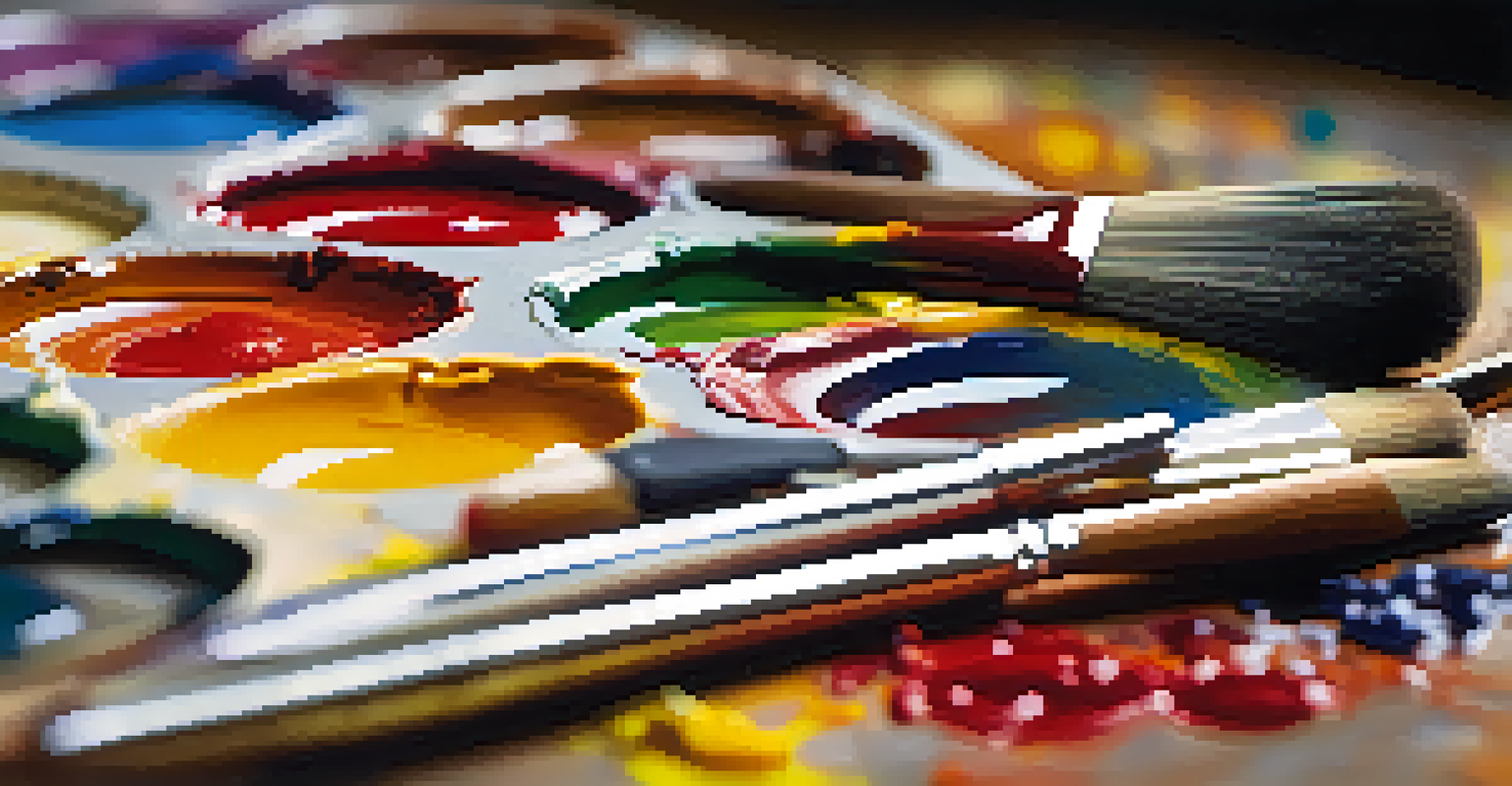The Role of the Artist: Intent vs. Interpretation in Painting

Understanding the Artist's Intent in Painting
Every painting begins with the artist's intent, a crucial element that shapes the artwork. This intent can be influenced by personal experiences, societal issues, or emotional states. For instance, an artist might create a piece to express joy, sadness, or a commentary on cultural norms. Recognizing this intent helps viewers appreciate the depth and thought behind the artwork.
Art is not freedom from discipline, but disciplined freedom.
However, intent is not always clearly communicated through the brushstrokes or colors chosen. Artists may leave aspects ambiguous, inviting viewers to explore their interpretations. This duality between what the artist aims to convey and what the viewer perceives can spark intriguing conversations about the nature of art itself.
Ultimately, understanding the artist's intent can enhance our engagement with the painting. By recognizing the motivations and background that inform a piece, we can gain a richer appreciation for the layers of meaning embedded within it.
The Power of Interpretation in Art Appreciation
Interpretation is where the magic of art truly unfolds. Viewers bring their own experiences, emotions, and cultural backgrounds to the table, which can dramatically alter their understanding of a piece. For instance, a landscape painting may evoke feelings of nostalgia in one person while sparking a sense of adventure in another. This unique interaction between the viewer and the artwork showcases the subjective nature of art.

Moreover, interpretation encourages dialogue among audiences. When people share their perspectives on a painting, they can uncover new meanings and insights that the artist may not have explicitly intended. This exchange can lead to a deeper communal understanding of the artwork, enriching the overall experience.
Artist Intent Shapes Artwork Meaning
Understanding the artist's intent enriches our engagement with the artwork, revealing the deeper motivations behind the piece.
However, it’s important to remember that not all interpretations hold equal weight. Some may align closely with the artist's intent, while others may diverge significantly. This variance doesn't diminish the value of personal interpretation; rather, it highlights the multifaceted nature of art.
The Intersection of Intent and Interpretation
At the heart of every painting lies a fascinating intersection between intent and interpretation. While an artist may have a specific message in mind, the viewer's interpretation can shift that message in unexpected ways. This dynamic relationship is what keeps art alive and relevant across generations, as each viewer brings something fresh to the conversation.
The more I paint, the more I realize that art is not about what you see, but what you make others see.
For example, consider Picasso's 'Guernica.' Its stark portrayal of war was intended as a powerful anti-war statement, yet viewers have interpreted it in various ways over the decades. Some see it as a universal cry against suffering, while others focus on its historical context. This blend of interpretation allows the artwork to resonate with diverse audiences.
In this way, the artist’s intent and the viewer's interpretation dance together, creating a rich tapestry of meaning. Both aspects are essential in appreciating art, as they highlight not only the artist's vision but also the audience's engagement.
The Role of Context in Interpretation
Context plays a pivotal role in shaping how we interpret art. Factors such as historical background, cultural significance, and even the environment where the painting is displayed can influence our understanding. For instance, a piece displayed in a contemporary gallery may be viewed differently than if it were hung in a traditional museum setting.
Additionally, the context of the viewer's life can impact interpretation. Someone who has experienced a significant life event may relate to a painting in a way that others cannot. This personal lens adds layers to the artwork, making it a deeply individual experience.
Interpretation is Subjective and Unique
Viewers bring their own experiences to art, leading to diverse interpretations that can enhance communal dialogue.
Therefore, when we consider context, we open ourselves to a broader spectrum of interpretations. Understanding the various influences at play allows us to appreciate not just the artwork itself, but the larger conversation it participates in.
Art as a Reflection of Society and Culture
Art often serves as a mirror reflecting societal values and cultural norms. Through their work, artists comment on issues ranging from politics to identity, providing a lens through which viewers can examine these themes. For example, works from the Harlem Renaissance captured the struggles and triumphs of African American life, prompting dialogue about race and culture.
As society evolves, so too does the interpretation of art. A painting that once resonated with a specific audience may take on new meanings as cultural contexts shift. This fluidity can spark renewed interest in historical works, as contemporary viewers find relevance in their messages.
Thus, art not only conveys the artist's intent but also invites us to engage with our own cultural narratives. By recognizing this interplay, we can better appreciate how art functions as both a personal expression and a societal commentary.
The Artist's Responsibility in Conveying Intent
Artists carry a certain responsibility when it comes to conveying their intent. While the beauty of art lies in its openness to interpretation, clarity can enhance understanding. When an artist takes care to express their message thoughtfully, it can guide viewers toward a more meaningful interpretation.
That said, it’s a delicate balance. An artist must decide how much to reveal about their intent without limiting the audience’s personal connection to the work. Over-explaining can strip away the mystery and allure that often draws people to art in the first place.
Context Influences Art Interpretation
The historical and personal context in which a painting is viewed significantly impacts how it is interpreted and appreciated.
Ultimately, the artist’s responsibility lies in creating a space for dialogue. By inviting viewers to explore their interpretations while providing enough context to spark curiosity, artists can foster a deeper appreciation for their work.
Conclusion: Embracing the Complexity of Art
The relationship between an artist's intent and the viewer's interpretation is a complex yet beautiful aspect of painting. It reminds us that art is not a one-way street; it's a conversation that evolves with each new viewer. By embracing this complexity, we can cultivate a richer understanding of both the artwork and ourselves.
As we engage with paintings, let’s recognize the layers of meaning that come from both the artist's vision and our own experiences. This interplay not only enhances our appreciation for art but also enriches our lives, connecting us to diverse perspectives and interpretations.

In the end, the beauty of art lies in its ability to resonate differently with each individual, creating a tapestry of meanings that reflect our shared human experience.